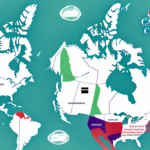Understanding UPS Shipping Rates from the USA to Canada
Shipping packages from the USA to Canada can be streamlined and efficient with UPS, one of the most reliable and convenient shipping options available. However, it's crucial to comprehend the various factors that influence UPS shipping rates to Canada before initiating your shipments. This guide provides an in-depth analysis of UPS shipping rates to Canada, including the benefits of using UPS, methods to calculate shipping costs, and strategies for saving money. Additionally, we cover essential documents required for international shipments and best practices for packaging your items.
The Benefits of Using UPS for Shipping from the USA to Canada
Choosing UPS for shipping from the USA to Canada offers numerous advantages:
- Reliable Tracking and Delivery Confirmation: UPS provides comprehensive tracking services, allowing you to monitor your package's journey from origin to destination. This ensures peace of mind and enhanced security.
- Variety of Shipping Options: UPS offers multiple shipping methods, including ground, air, and expedited services. This flexibility allows you to select the most suitable option based on your budget and delivery timeframe.
- Extensive International Network: With a robust network of international partners, UPS ensures faster and more efficient delivery of packages to Canada. This network also facilitates easier navigation through customs and regulatory requirements.
- Customs Clearance Expertise: UPS employs a team of experts who assist in managing complex customs regulations and paperwork, minimizing delays and ensuring a smooth delivery process.
- Competitive Pricing: Leveraging negotiated rates with international partners, UPS offers affordable shipping options, particularly beneficial for businesses with high shipping volumes. According to UPS [Annual Report 2023](https://www.ups.com/us/en/resources/about-ups.page), UPS continues to maintain competitive pricing through strategic partnerships and operational efficiencies.
Factors that Affect UPS Shipping Rates from the USA to Canada
Several factors influence UPS shipping rates to Canada:
- Package Weight and Dimensions: Larger and heavier packages incur higher shipping costs. UPS uses dimensional weight pricing for packages, which factors in both size and weight.
- Distance Between Origin and Destination: Greater distances typically result in higher shipping rates due to increased transportation costs.
- Delivery Timeframe: Faster shipping options like air or expedited services are more expensive compared to ground shipping.
- Type of Item Being Shipped: Hazardous or restricted items may require special handling and documentation, increasing shipping costs. Refer to [UPS Hazardous Materials](https://www.ups.com/us/en/services/shipping-services/international/hazardous-materials.page) for more details.
- Additional Fees and Taxes: International shipments to Canada may be subject to customs duties, taxes, and brokerage fees. These charges vary based on the package's value and contents. The Canada Border Services Agency provides detailed information on [import duties and taxes](https://www.cbsa-asfc.gc.ca/import/menu-eng.html).
How to Calculate UPS Shipping Rates from the USA to Canada
Calculating UPS shipping rates to Canada involves the following steps:
- Measure and Weigh Your Package: Accurately determine the dimensions and weight of your package to ensure precise rate calculation.
- Determine Origin and Destination Zip Codes: Use the correct postal codes to get an accurate shipping quote.
- Use the UPS Shipping Rate Calculator: Visit the UPS Rate Calculator on the official UPS website to obtain an estimated cost based on your package details.
- Select Shipping Options: Choose your preferred shipping method (ground, air, expedited) to refine your cost estimate.
UPS also offers various tools and resources to assist in preparing your package for international shipping, including guidelines on [customs regulations](https://www.ups.com/ca/en/help-center/packaging-and-supplies.page), required documentation, and packaging best practices.
Tips for Saving Money on UPS Shipping Rates to Canada
Implementing the following strategies can help you reduce UPS shipping costs to Canada:
- Opt for Ground Shipping: Ground shipping is generally more economical compared to air or expedited services. If time permits, choosing ground can lead to significant savings.
- Negotiate Shipping Rates: Businesses with high shipping volumes can negotiate discounted rates with UPS. Contact your UPS account representative to explore available discounts.
- Utilize Discounts and Promotions: Keep an eye out for UPS promotions or seasonal discounts that can lower shipping costs.
- Efficient Packaging: Use appropriately sized packaging to minimize dimensional weight charges. Efficient packaging not only reduces shipping costs but also decreases the likelihood of damage during transit.
- Compare Rates with Other Carriers: Use a shipping calculator to compare rates from different carriers like FedEx or DHL. Tools like ShipScience's Shipping Comparison can help identify the most cost-effective option for your needs.
- Consolidate Shipments: Combining multiple shipments into a single package can take advantage of bulk shipping rates, reducing overall costs.
Comparing UPS Shipping Rates with Other Carriers for Canadian Deliveries
When selecting a shipping carrier for deliveries to Canada, it's essential to compare UPS rates with other major carriers such as FedEx and DHL:
- Shipping Rates: Conduct a rate comparison to determine which carrier offers the most competitive pricing for your specific shipping needs. Recent studies, such as the [2023 Shipping Cost Comparison](https://www.logisticsmagazine.com/shipping-cost-comparison-2023), highlight the varying rates among carriers based on package size, weight, and delivery speed.
- Delivery Timeframes: Compare the delivery options and estimated delivery times. UPS offers standard, expedited, and express services, each with varying delivery durations. Ensure the chosen carrier meets your timeframe requirements.
- Customer Service: Evaluate the quality of customer support provided by each carrier. UPS is renowned for its excellent customer service, with dedicated support teams available to address queries and concerns. Other carriers may offer similar services, but researching customer reviews and ratings can provide additional insights.
- Additional Services: Consider value-added services such as package tracking, insurance options, and ease of customs clearance. These services can enhance the overall shipping experience and provide added security.
Ultimately, the best carrier for your shipments to Canada will depend on your specific requirements, including budget, delivery speed, and the nature of the items being shipped.
Understanding the Delivery Timeframe for UPS Shipments to Canada
The delivery timeframe for UPS shipments to Canada varies based on the selected shipping method and the distance between the origin and destination. Typical delivery times include:
- Ground Shipping: Approximately 5-7 business days.
- Air Shipping: Approximately 2-3 business days.
It's important to note that delivery times can be influenced by additional factors:
- Customs Clearance: Packages requiring customs inspection may experience delays. Ensuring all documentation is accurate and complete can expedite the clearance process.
- Weather Conditions: Severe weather events such as snowstorms or hurricanes can disrupt transportation and cause delivery delays.
- Peak Shipping Seasons: During high-demand periods like holidays, shipping times may be extended due to increased volume.
To stay informed about your shipment's status, utilize UPS's tracking services and sign up for delivery notifications.
Important Documents Needed for International UPS Shipments to Canada
When shipping items internationally from the USA to Canada via UPS, specific documents are required to ensure smooth customs clearance and delivery:
- Commercial Invoice: A detailed invoice listing the items being shipped, their value, and their purpose (e.g., sale, gift, return). This document is critical for customs valuation and duty assessment.
- NAFTA Certificate of Origin: If eligible, this certificate can reduce or eliminate tariffs under the United States-Mexico-Canada Agreement (USMCA). Ensure that your products qualify and the certificate is accurately completed.
- Certificate of Insurance: Provides proof of insurance coverage for the shipment's value, offering protection against loss or damage.
- Bill of Lading: A shipment receipt issued by UPS, detailing the terms and conditions of the transportation.
- Packing List: An inventory of the shipped items, including quantities, weights, and descriptions. This assists customs officials in verifying the shipment contents.
For detailed information on required documentation, visit the UPS International Shipping Guide and consult the [Canada Border Services Agency](https://www.cbsa-asfc.gc.ca/import/menu-eng.html) for specific import requirements.
Best Practices for Preparing and Packaging Your Shipment for UPS Delivery to Canada
Proper packaging is essential to protect your items and ensure they meet UPS and Canadian import standards. Follow these best practices:
- Use Sturdy Packaging Materials: Choose high-quality, durable boxes that can withstand the rigors of international transit. Reinforce corners and seams with strong packing tape.
- Appropriate Box Size: Select a box size that accommodates your items without excessive empty space. Minimizing package size can reduce dimensional weight charges.
- Secure Packaging: Utilize adequate padding materials such as bubble wrap, packing peanuts, or foam inserts to cushion items and prevent movement within the box.
- Label Clearly: Clearly label your package with the recipient's full name, address, and phone number. Include your return address as well.
- Include Necessary Documentation: Ensure all required documents are securely attached to the outside of the package in a clear, waterproof pouch.
- Compliance with UPS Guidelines: Adhere to UPS’s [packaging guidelines](https://www.ups.com/us/en/help-center/packaging-and-supplies.page) to avoid any issues during transit.
- Consider Insurance: For valuable or fragile items, purchasing additional insurance can provide added protection against loss or damage.
Common Mistakes to Avoid When Shipping with UPS from the USA to Canada
Avoid these common pitfalls to ensure a smooth shipping experience with UPS:
- Poorly Prepared Packages: Inadequate packaging can lead to damaged goods. Always use appropriate materials and follow packaging best practices.
- Incorrect or Incomplete Address Information: Double-check recipient addresses for accuracy to prevent delivery delays or misrouting.
- Incomplete Documentation: Missing or incorrect customs documents can result in delays, fines, or even seizure of the package. Ensure all required forms are accurately filled out.
- Improper Declaration of Contents: Accurately declare the contents and value of your shipment to avoid legal issues and ensure proper duty assessment.
- Neglecting to Check Import Regulations: Some items may be restricted or require special permits for import into Canada. Consult the [Canada Border Services Agency](https://www.cbsa-asfc.gc.ca/import/menu-eng.html) to verify if your items are permissible.
- Not Tracking Your Shipment: Failing to monitor your package's status can lead to missed updates or unresolved issues. Utilize UPS's tracking tools to stay informed.
By adhering to these guidelines and avoiding common mistakes, you can enhance the efficiency and reliability of your international shipments with UPS.
With a comprehensive understanding of UPS shipping rates and best practices for international shipping, you can confidently send your packages from the USA to Canada, leveraging UPS’s reliable services to meet your delivery needs.
For more detailed information and assistance, consider consulting with a UPS shipping expert or visiting the official UPS website.




















